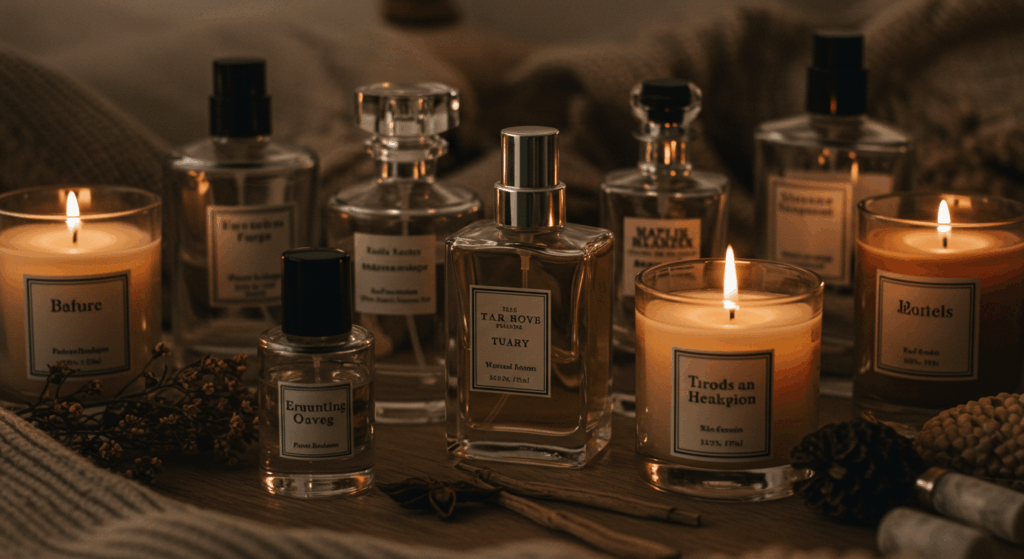Table of Contents
Choosing your first signature scent is a deeply personal and exciting experience. A signature scent reflects your personality, complements your lifestyle, and leaves an unforgettable impression. But with thousands of options on the market, navigating the world of fragrances for the first time can feel overwhelming. Where do you start? How do you choose a perfume that aligns with your preferences and body chemistry?
This guide will walk you through everything you need to know about choosing your first signature scent. From understanding fragrance families to experimenting with sampling strategies, by the end of this guide, you’ll feel confident in finding the perfect scent that feels uniquely “you.”
Understanding Fragrance Families
Before you start sampling fragrances, it’s essential to understand the main fragrance families. Think of them as categories that define specific scent profiles. These families guide you toward scents you’ll enjoy, as they align with distinct personality types and preferences.
1. Floral Scents
Floral perfumes are among the most popular categories, boasting notes of flowers like rose, jasmine, and lavender. These are ideal for individuals who lean toward classic, fresh, or feminine scents.
- Examples: Consider Chanel No. 5 for a soft floral powdery scent, or a more affordable option like Al Rasasi Perfumes Romance, which is beautifully delicate.
2. Woody Scents
Woody fragrances are rich and grounded, often featuring earthy ingredients like sandalwood, cedarwood, or vetiver. They’re perfect if you want a scent that’s sophisticated and serene.
- Examples: Fragrances boasting sandalwood oil are highly sought-after for their warmth and strength. Try Tom Ford’s Oud Wood or explore Attar-based woody oils for a traditionally rich approach.

3. Oriental Scents
Oriental fragrances combine spicy, sweet, and sensual notes like vanilla, amber, and incense. Oud-based fragrances, like those under the Bakhoor family, are prominent in this group, exuding opulence and mystique.
- Benefits of Bakhoor: Traditionally popular in Middle Eastern culture, Bakhoor refers to incense chips often enhanced with rich oils like oud. Using Bakhoor in homes not only perfumes spaces but also enhances relaxation.
4. Fresh Scents
Fresh fragrances are crisp, clean, and invigorating, often featuring citrus, marine, and green notes. These work wonderfully for active lifestyles or warmer climates.
5. Gourmand Scents
If you love edible, sweet aromas, gourmand perfumes with notes like chocolate, caramel, and almond might be for you. They’re playful and comforting.
Understanding these families will help you start narrowing down which profiles resonate with your personal style.
Considering Your Preferences
Your Personal Style and Identity
Ask yourself what kind of impression you’d like to leave. Are you elegant and poised? You might love a floral perfume. Are you bold and adventurous? Perhaps a smoky oud or musk-based fragrance would suit you. Aligning your scent with your wardrobe and lifestyle ensures it feels authentically “you.”
Your Environment
Consider where you’ll wear your fragrance. Heavier perfumes like Eau de Parfum (EDP) work well for evening events, while lighter options like Eau de Toilette (EDT) or Eau de Cologne (EDC) suit daily wear in professional settings.
Body Chemistry
Fragrances react differently with everyone’s skin due to factors like pH and natural oils. Understanding how to choose the right perfume for your body chemistry is key. Test fragrances on your skin rather than relying on paper strips alone to experience the “true” scent.
Sampling Strategies
Before committing to a full bottle, take time to sample different fragrances. Here’s how to do it effectively:
Spray Directly on Skin
Each fragrance smells slightly different on a person depending on their body chemistry. Spray the fragrance on your wrists or the crook of your elbow and allow it to develop over a few hours to experience all the layers of the scent.
Use Pulse Points
Apply fragrances to areas like your neck, wrists, or behind your ears. These “pulse points” radiate warmth, enhancing the scent’s projection and longevity.
Time of Day Testing
Test fragrances during different times of the day. Morning testing ensures a fresh nose, while testing later provides insight into how you experience scents after prolonged exposure.
Stick to Three Samples
Smelling too many perfumes in one go can lead to olfactory fatigue. Limit yourself to three samples per session and sniff coffee beans between each test to reset your sense of smell.
Seasonal Considerations
Summer Scents
For warm weather, opt for lighter, fresh fragrances. Citrus-based Eau de Cologne (EDC) or aquatic Eau de Toilette (EDT) scents are ideal, as they feel refreshing in the heat.
Winter Scents
Heavier, richer fragrances shine in colder months. Look for Eau de Parfum (EDP) formulas with notes of oud, vanilla, or amber to create a sense of warmth and coziness.
Budget-Friendly Options for Beginners
High-quality fragrances don’t always mean breaking the bank. Many budget-friendly brands offer excellent scents perfect for beginners. Explore brands like Al Rasasi Perfumes for affordable yet delightful fragrances. Some must-try picks include accessible attar oils or mini bottles for experimentation without overspending.
Pro Tip: Consider exploring fragrance subscription services that send monthly samples for a low cost, helping you discover your signature scent without committing too quickly.
Longevity and Sillage
What is Longevity?
Longevity refers to how long a fragrance lasts on your skin. Heavier scents like Oriental EDPs tend to last for hours, while lighter scents such as EDTs fade quicker.
What is Sillage?
Sillage defines the scent trail left behind when you move. If you want a noticeable but not overwhelming presence, go for moderate sillage. Fragrances featuring musk or sandalwood oil often excel in this area.
Understanding these factors ensures your signature scent performs the way you envision for your daily activities.
Embark on the Journey
Choosing your first signature scent is less about finding the single “perfect” fragrance and more about the joy you discover in the process. It’s okay to experiment, test new profiles, and even have different scents for different occasions or seasons.
Take your time and enjoy each experience (or mistake) as you explore how to choose a perfume for a woman (or yourself)! Consider trying Bakhoor or types of Attar if you’re looking for something unique and cultural.
Above all, your signature scent should make you feel confident and authentic. Once you’ve found “the one,” wear it proudly like an invisible accessory defining your presence wherever you go.
FAQs
1. How do you choose the right perfume for your body chemistry?
Choose a perfume that complements your natural scent. Always test fragrances on your skin and give them time to develop for an accurate impression of how they interact with your body chemistry.
2. What are some signature scent examples for beginners?
Some popular options include floral fragrances like Chanel No. 5, woody scents featuring sandalwood oil, and oriental perfumes containing oud or amber.
3. What is the difference between Eau de Cologne, Eau de Toilette, and Eau de Parfum?
- Eau de Cologne (EDC): Light and refreshing, with a lower concentration of perfume oils.
- Eau de Toilette (EDT): Slightly stronger than EDC, ideal for daily wear.
- Eau de Parfum (EDP): The most concentrated and long-lasting option, perfect for evenings or special occasions.
4. What is Bakhoor, and how is it used?
Bakhoor, a type of incense, is made from chips soaked in scented oils like oud. It’s used to perfume spaces or enhance relaxation.
5. How do you sample fragrances effectively?
Limit yourself to three samples, test on your skin, and give each fragrance time to develop fully before deciding.














Leave a comment